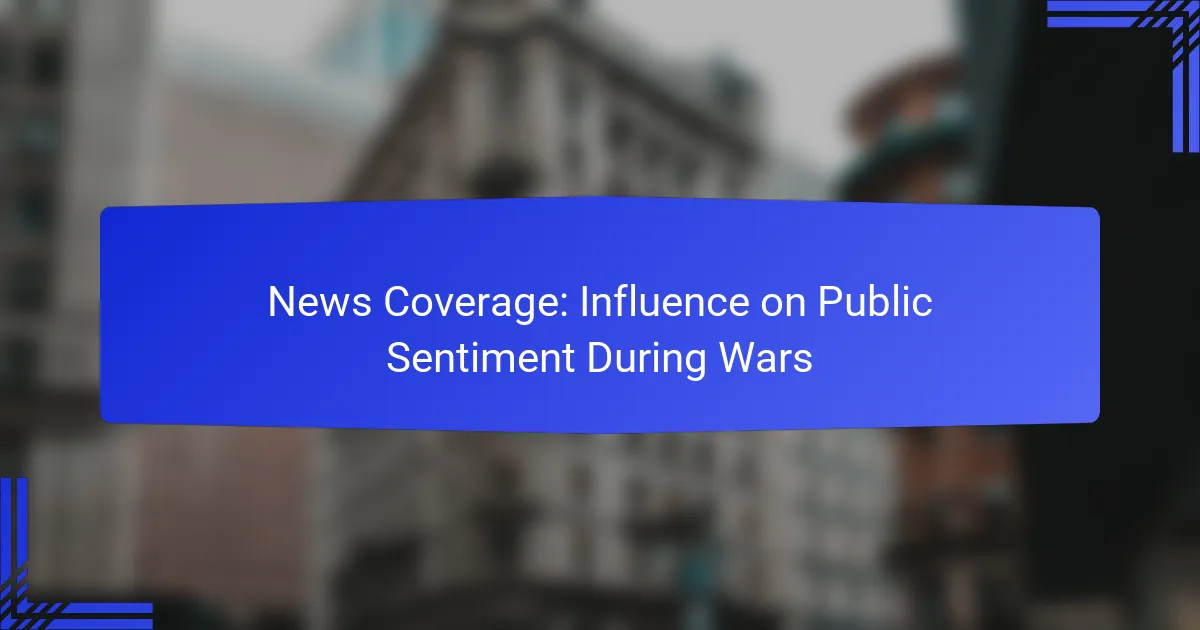News coverage plays a pivotal role in shaping public sentiment during wars, as it frames narratives and influences perceptions. Through various strategies such as balanced reporting and personal stories, media can either rally support for military actions or incite dissent. Historical examples like the Vietnam War and the Iraq War illustrate how media coverage of international conflicts significantly impacts public opinion and policy decisions.
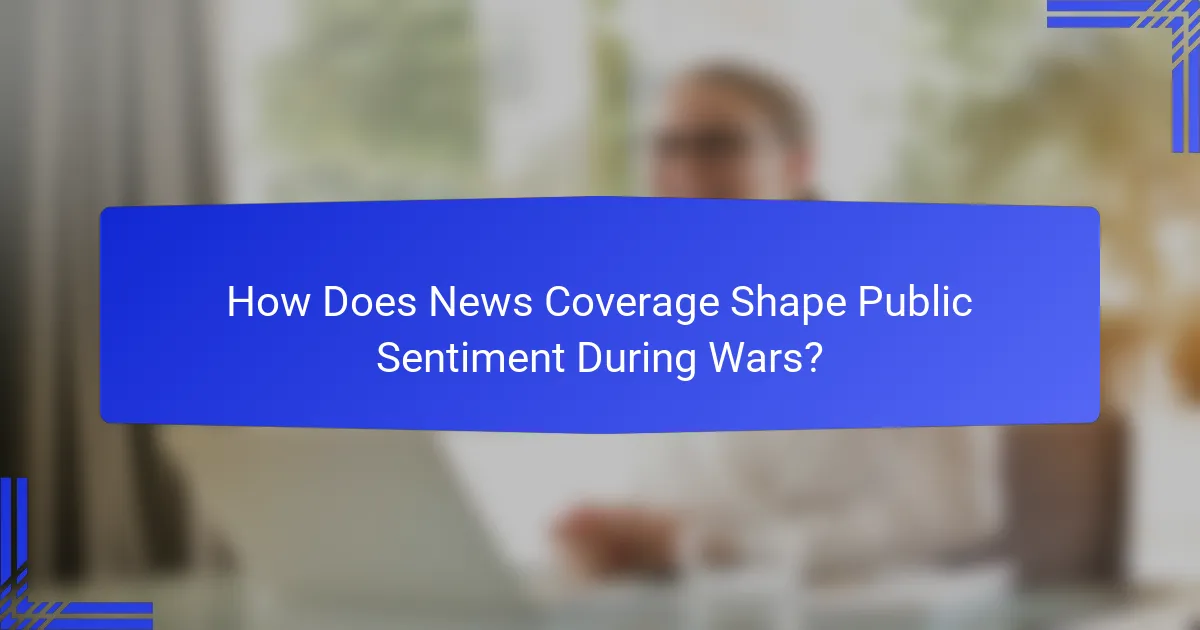
How Does News Coverage Shape Public Sentiment During Wars?
News coverage significantly influences public sentiment during wars by framing narratives and shaping perceptions. The way information is presented can alter public opinion, either rallying support for military actions or fostering dissent.
Influence of media framing
Media framing refers to the way news outlets present information, which can affect how audiences interpret events. For instance, portraying a conflict as a fight for freedom can generate public support, while framing it as an imperialistic invasion may lead to opposition. The choice of words, images, and context plays a crucial role in shaping these frames.
Different media outlets may emphasize various aspects of a conflict, leading to polarized public perceptions. For example, one outlet might highlight civilian casualties, while another focuses on military victories, creating divergent narratives that influence public sentiment.
Role of emotional narratives
Emotional narratives in news coverage can evoke strong feelings, which significantly impact public sentiment during wars. Stories that humanize individuals affected by conflict, such as personal accounts of loss or heroism, can foster empathy and support for military actions. Conversely, narratives that depict suffering can provoke outrage and calls for peace.
Using emotional appeals, such as visuals of affected families or poignant interviews, can sway public opinion more effectively than mere statistics. This emotional engagement often drives social media sharing, amplifying the reach and impact of these narratives.
Impact of misinformation
Misinformation can severely distort public sentiment during wars, leading to confusion and misplaced trust. False reports or exaggerated claims can create panic or unwarranted support for military actions, complicating the public’s understanding of the conflict. For example, misleading images or fabricated stories can go viral, shaping opinions based on inaccuracies.
To combat misinformation, it is crucial for consumers to verify information from multiple reputable sources. Engaging with fact-checking organizations and being aware of potential biases in news coverage can help individuals form a more accurate understanding of the situation.
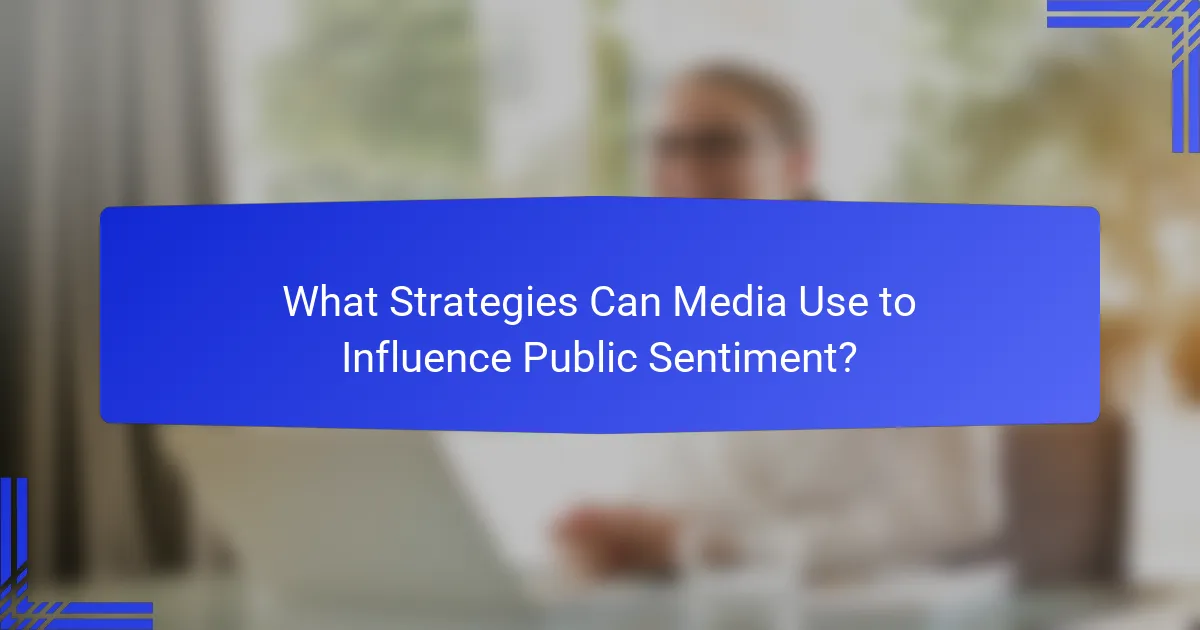
What Strategies Can Media Use to Influence Public Sentiment?
Media can influence public sentiment during wars through various strategies, including balanced reporting, expert opinions, and personal stories. These techniques help shape perceptions and can significantly impact public opinion and policy decisions.
Balanced reporting techniques
Balanced reporting involves presenting multiple perspectives on a conflict to provide a comprehensive view. This approach helps audiences understand the complexities of war, rather than viewing it through a single lens. For instance, showcasing both military and civilian impacts can foster a more nuanced public sentiment.
To achieve balance, media outlets should strive to include voices from various stakeholders, such as government officials, military personnel, and civilians affected by the conflict. This diversity in reporting can mitigate bias and enhance credibility, ultimately influencing how the public perceives the war.
Use of expert opinions
Incorporating expert opinions can lend authority to media narratives and help clarify complex issues surrounding a war. Experts, such as political analysts, military strategists, and humanitarian workers, can provide insights that inform public understanding and sentiment. Their analyses can highlight the implications of military actions or the humanitarian crises that arise.
Media should ensure that experts represent a range of viewpoints to avoid echo chambers. By featuring differing opinions, outlets can encourage critical thinking among audiences, prompting them to engage more deeply with the issues at hand.
Incorporating personal stories
Personal stories humanize the impact of war and can evoke empathy from the audience. By sharing narratives from individuals directly affected by the conflict, media can create a powerful emotional connection that shapes public sentiment. For example, interviews with refugees or frontline medical workers can illustrate the human cost of war.
To effectively incorporate personal stories, media should focus on authenticity and relatability. Highlighting diverse experiences can resonate with a wider audience, fostering a sense of shared humanity that transcends political or ideological divides.
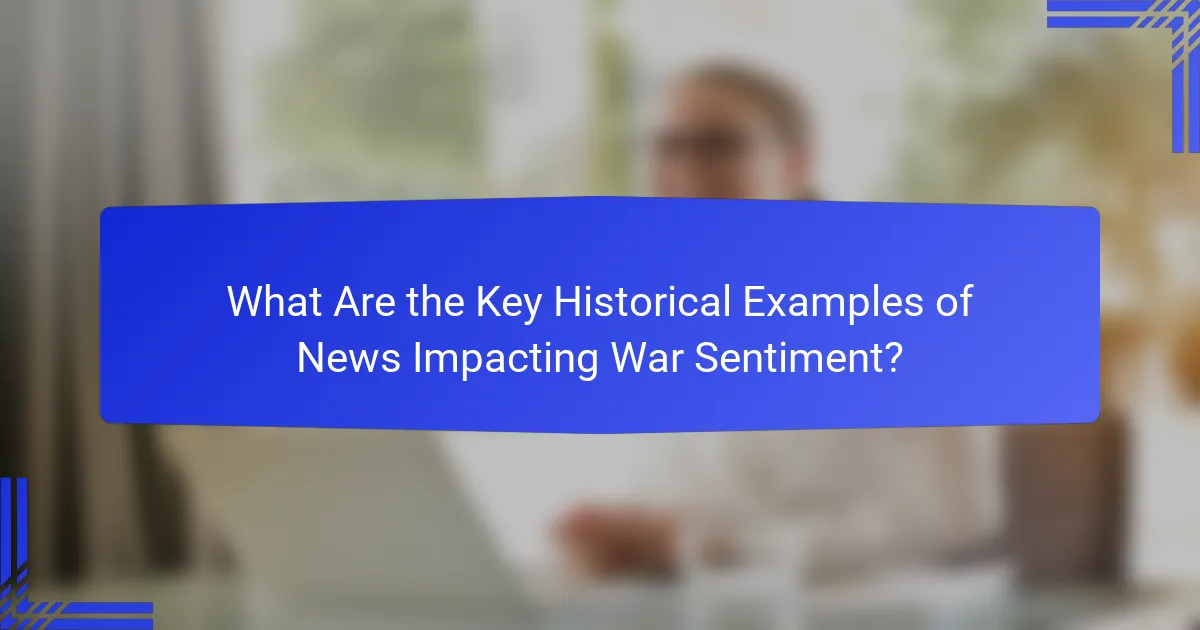
What Are the Key Historical Examples of News Impacting War Sentiment?
News coverage has historically played a crucial role in shaping public sentiment during wars, influencing perceptions and attitudes toward military actions. Key examples include the Vietnam War, the Gulf War, and the Iraq War, each demonstrating how media narratives can sway public opinion and policy decisions.
Vietnam War coverage
The Vietnam War marked a significant shift in how media coverage affected public sentiment. Graphic images and reports of casualties broadcasted on television brought the realities of war into American living rooms, leading to widespread protests and a decline in support for the conflict.
As the war progressed, the disparity between government reports and media portrayals created a credibility gap. This gap fueled anti-war sentiment, as many Americans began to question the motives and effectiveness of U.S. involvement in Vietnam.
Gulf War reporting
The Gulf War showcased a different approach to media coverage, with the U.S. government tightly controlling information. The use of “embedded” journalists allowed for real-time reporting, but it also meant that narratives were often favorable to military operations, shaping public perception positively.
Despite the controlled environment, images of the conflict and its aftermath still sparked debates about the war’s justification and humanitarian impacts. Public sentiment was largely supportive, but concerns about media manipulation emerged as a critical discussion point.
Coverage of the Iraq War
The Iraq War highlighted the complexities of media influence on public sentiment. Initial coverage focused on the rationale for invasion, including claims of weapons of mass destruction, which garnered significant support. However, as the war dragged on and casualties mounted, media narratives shifted to highlight the challenges faced by U.S. forces.
Public opinion became increasingly polarized, with many Americans expressing disillusionment as reports of violence and instability in Iraq became more prominent. This shift in coverage ultimately contributed to declining support for the war and calls for troop withdrawal.
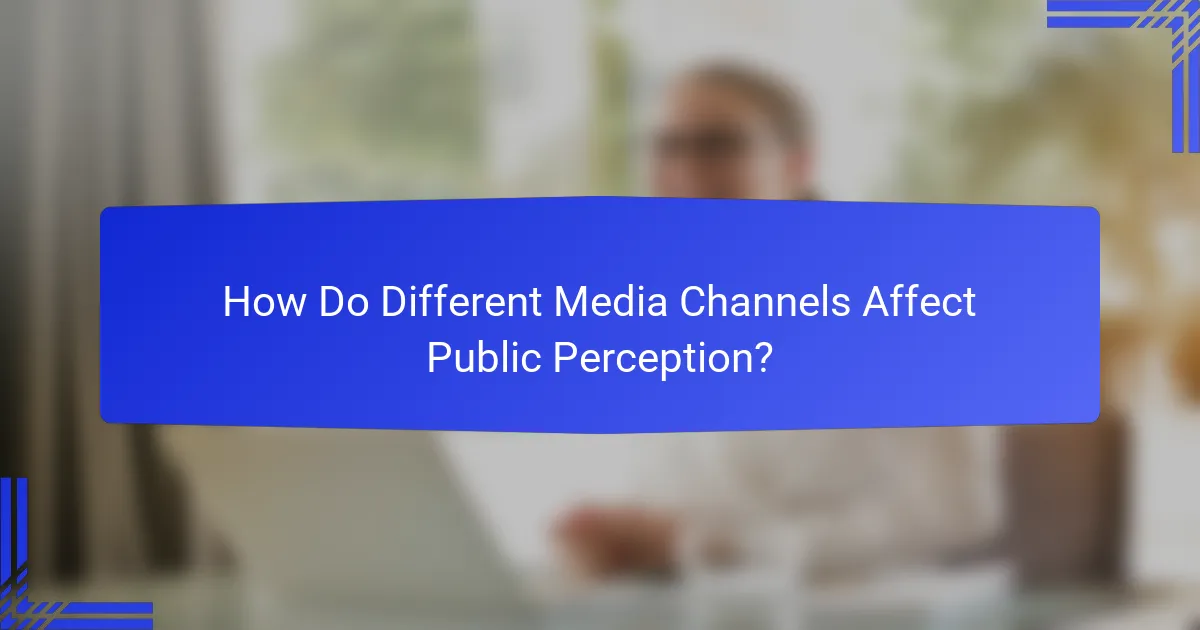
How Do Different Media Channels Affect Public Perception?
Different media channels significantly shape public perception during wars by influencing how information is presented and consumed. Each channel has unique characteristics that can either amplify or mitigate public sentiment based on the content and delivery method.
Television vs. print media
Television often provides immediate visual coverage, which can evoke strong emotional responses from viewers. This immediacy can lead to heightened public sentiment, as images of conflict can create urgency and empathy.
In contrast, print media allows for more in-depth analysis and context, which can help readers understand complex issues. However, the slower dissemination of information may result in a lag in public reaction compared to the rapid updates seen on television.
Social media’s role
Social media platforms serve as real-time information hubs where users can share and discuss news, significantly impacting public sentiment. The viral nature of posts can amplify specific narratives, leading to polarized opinions.
However, the spread of misinformation is a critical concern on social media. Users must critically evaluate sources and verify information to avoid being swayed by false narratives that can distort public perception during conflicts.
Online news platforms
Online news platforms combine the immediacy of television with the depth of print media, offering multimedia content that can engage audiences effectively. They often provide updates, analysis, and user-generated content, allowing for a more comprehensive view of events.
However, the abundance of information can overwhelm readers, making it essential to identify credible sources. Users should seek out reputable online news outlets to ensure they receive accurate and balanced coverage, which is crucial for informed public sentiment during wars.
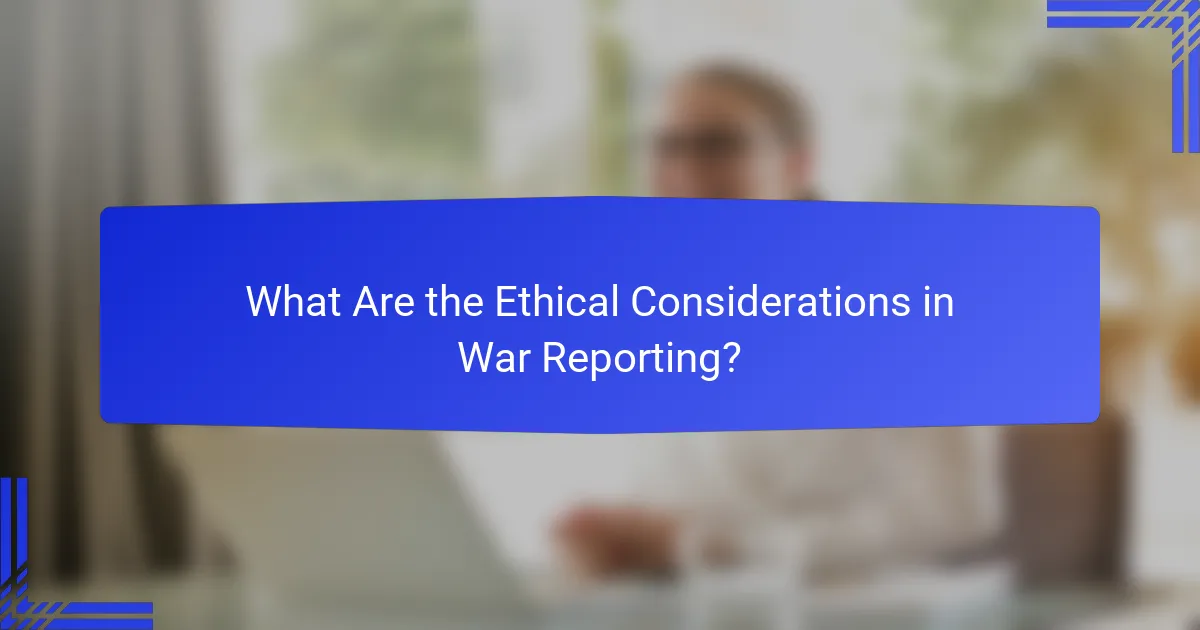
What Are the Ethical Considerations in War Reporting?
Ethical considerations in war reporting involve maintaining integrity, accuracy, and sensitivity to the impact of coverage on public sentiment. Journalists must navigate the fine line between informing the public and potentially inflaming emotions or spreading misinformation.
Accuracy and fact-checking
Accuracy in war reporting is crucial, as misinformation can lead to public panic or misguided actions. Journalists should verify facts through multiple reliable sources before publication, especially when covering rapidly evolving situations. Utilizing established fact-checking organizations can enhance credibility.
For example, during conflicts, reports of casualties or military actions should be corroborated with official statements or eyewitness accounts. A commitment to accuracy helps maintain trust with the audience and ensures responsible journalism.
Responsibility to avoid sensationalism
Journalists have a responsibility to avoid sensationalism, which can distort public perception and escalate tensions. Sensational headlines or graphic imagery may attract attention but can also desensitize audiences or promote fear. Striking a balance between engaging storytelling and factual reporting is essential.
To mitigate sensationalism, reporters should focus on the human aspects of war, such as personal stories of those affected, rather than solely on dramatic events. This approach fosters empathy and a more nuanced understanding of the conflict.

How Can Consumers Critically Evaluate War News Coverage?
Consumers can critically evaluate war news coverage by actively analyzing the information presented and questioning its sources and intent. This involves recognizing potential biases, cross-referencing multiple outlets, and understanding the context behind the reporting.
Identifying bias in reporting
Identifying bias in reporting requires careful attention to language, tone, and the framing of events. Look for emotionally charged words or one-sided narratives that may indicate a particular agenda. For example, terms like “aggressor” versus “defender” can shape public perception significantly.
Consider the ownership and funding of the media outlet as well. Different organizations may have political affiliations or financial interests that influence their reporting style. A news source funded by a government may present information differently than an independent outlet.
Cross-referencing multiple sources
Cross-referencing multiple sources is essential for obtaining a balanced view of war coverage. By consulting various news outlets, including international perspectives, consumers can identify discrepancies and gain a more comprehensive understanding of the situation. Aim to compare at least three different sources to spot trends or common themes.
Utilize fact-checking websites and independent journalism platforms to verify claims made in news articles. These resources can help distinguish between verified information and unsubstantiated reports, ensuring that your understanding is based on accurate data rather than sensationalism.
